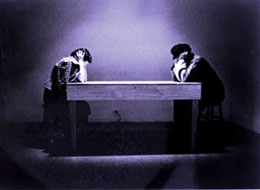

|
I've always thought that one of the most serious defects of the human body was that you couldn't close your ears.
You can't point them anywhere or close them, they just sort of hang there on the sides of your head. But an acupuncturist explained to me that the pressure points in ears are very important because the whole body is represented right there in the ear. The ear, he said, are vestigial fetuses, little versions of yourself, one male and one female. And he showed me here's the lobe, that's the miniature upside down head, and this curve here is the spine and right here are the little genitals and that was when I went back to wearing hats.
From "Voices from the Beyond" 1990 |

|
Melencolia I is an interesting piece of work, as it deviates from Dürer's usual religious iconography and, instead, embodies the creative man, the artist, the scholar, and the alchemist. This engraving was created the same year that Dürer's mother died, which may provide a clue to the desperation embodied in this work.
In this piece, the angel of melancholy finds herself surrounded by many objects and tools, and yet she remains in a state of inaction, contemplating whatever sorrow is eating away at her heart. She is described as "winged, yet cowering on the ground - wreathed, yet beclouded by shadows - equipped with the tools of art and science, yet brooding in idleness, she gives the impression of a creative being reduced to despair by an awareness of insurmountable barriers which separate her from a higher realm of thought" (Ponofsky, 168).
Alchemy, a medieval science best known for its attempts at material transformation in pursuit of wealth, was a common interest of many Renaissance artists. Many of the objects surrounding the angelic figure in Dürer's Melencolia I carry alchemical significance, such as the seven-rung ladder symbolizing the seven metals, and the magic number square which emphasizes the number four. Melancholy itself was considered one of the four humors in alchemical lore, an excess of which would lead to disease and insanity, and was often associated with autumn (Ponofsky, 157-158).
The Renaissance Humanists and Neo-Platonists, on the other hand, saw melancholy as a positive spiritual force, and channeled this energy into the act of creation. According to Ponofsky, "what had been a calamity and, in its mildest form, a handicap became a privilege still dangerous but all the more exalted: the privilege of genius" (Ponofsky, 165).
Some art historians such as Keith Moxey believe that it is impossible to step outside of time and find the objective, empirical truth concerning a piece of art, and we can only guess at how it was intended to be received within the boundaries of its own time (Moxey, 65). This opinion not only represents a common postmodern theme surrounding the disintegration of truth and the fallacy of history, but it also describes what Anderson does with Dürer's engraving. As an audience brings a predetermined viewpoint to a work, Anderson steps on to the stage of Melencolia I and makes her own personal production using the stage props of Dürer's symbols.
Anderson resurrects this Renaissance classic and breathes her own story into the "symbols [that] have multiple meanings and [that] have been interpreted in various ways" (Strieder, 260).
Stripped entirely of her possessions, Laurie Anderson clothes her naked life in the garments of Albrecht Dürer, and takes inventory of the remnants with a red ink pen. She borrows Dürer's images because she no longer has any of her own, save an electric socket and a pair of jeans with the zipper missing. She uses the particular work of Melencolia I as an incantation of sorts, to summon the Humanist spirits of long ago to help her transform such a negative experience into something positive and creative. As an artist, she finds a kinship with the medieval alchemists, attempting to use the raw elements of earth to make something valuable and divine. Laurie Anderson, herself, is rather familiar with combining and blending the elements to create something entirely new - she is rather a master of it.
Laurie takes this atmosphere of gloom and pulls from it something experimental and almost humorous. She revisits the images of the 16th century and bestows upon them an entirely new symbolic meaning. Her words alter our perception of Dürer's images, while his images also play a subtle effect on her words. Anderson's books become Dürer's keys; Dürer's square of magic numbers becomes Anderson's basis of music. The electric socket achieves a sort of divine presence, taking the form of a comet in the sky, heralding survival and a new beginning, laying the foundation for Anderson to begin again.
In short, Laurie Anderson takes a potentially destructive experience and shines a different light on the subject, channeling her creativity into borrowed images that engage the audience to explore the play on words and images. It becomes an example not only of Anderson's own personal exploratory style, but also gives us insight into one of the early postmodern examples of blending text with art - a method which has more recently seemed to stumbled into the realm of postmodern cliché.
